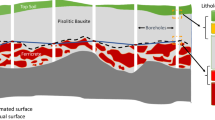Abstract
Three-dimensional modeling of a mineral deposit was conducted based on the samples collected from the surficial and deep parts of the deposit. One of the factors that affect the quality of data is the recovery of cores acquired during exploration drilling. As the core recovery reduces, the grade in core or drilling mud increases. Core loss can introduce unpredictable errors and negative or positive bias into the mineral resources estimation. Investigating the grade–recovery relationship in a bivariate space helps to detect the grade bias. In an ideal state, there is no correlation between grade and recovery. In case the grade–recovery relationship possesses a negative or positive correlation, the grade bias is likely to be due to core loss. In practice, however, because there are many data in boreholes sample database, the grade–recovery relationship is not properly determined on a simple scatter plot of grade versus core recovery. Application of conditional distributions in a bivariate space provides the necessary tool for investigating the simultaneous variations of grade and core recovery. Therefore, having converted the grade and core recovery data into the normal space, the conditional grade distribution was determined for various recoveries, and then, the conditional grades expectations were determined and plotted against the recovery to investigate the grade–recovery relationship. Application of the proposed method in three different deposits showed that in low recoveries, due to waste loss, the grade values were overestimated, whereas in high recoveries, due to ore loss, they were underestimated.











Similar content being viewed by others
References
Administrators, C. S. (2012). National Instrument 43-101 Standards of Disclosure for Mineral Projects, 43-101.
Annels, A. E. (1991). Mineral deposit evaluation: A practical approach. London: Chapman & Hall.
Annels, A. E., & Dominy, S. C. (2003). Core recovery and quality: important factors in mineral resource estimation. Applied Earth Science, 112(3), 305–312.
Code, J. O. R. C. (2012). Australaisian code for reporting of exploration results, mineral resources and ore reserves: The JORC Code–2012 Edition. AIG and MCA: Joint Ore Reserves Committee of AusIMM.
Committee, A. D. I. T. (1997). Drilling: The manual of methods, applications, and management. New York: CRC Press.
D2113-14 ASTM. (2014). Standard practice for rock core drilling and sampling of rock for site exploration. West Conshohocken, PA: ASTM International.
D6032, A. S. T. M. (2017). Standard test method for determining rock quality designation (RQD) of rock core. West Conshohocken, PA: ASTM International.
David, M. (1977). Geostatistical ore reserve estimation. Amsterdam: Elsevier.
Dekking, F. M., Kraaikamp, C., Lopuhaa, H. P., & Meester, L. E. (2005). A modern introduction to probability and statistics. London: Springer-Verlag.
Gocht, W. R., Zantop, H., & Eggert, R. G. (1988). International mineral economics. Berlin: Springer-Verlag.
Grant, D. E. C. S. (1981). Sampling in the Evaluation of Ore Deposits. M. Sc Dissertation, Rhodes University, South Africa.
Haldar, S. (2013). Mineral exploration: principles and applications. Waltham: Elsevier.
Hasanpor, S. H., Rasa, I., Heydari, M., Motakan, A. A., & Moayed, M. (2010). Alteration and Mineralization of Haftcheshmeh copper deposit. Iranian Journal of Geology, 15, 15–28.
Hassanipak, A. A. (2001). Mining sampling (2nd ed.). Tehran: Tehran University Press.
Hassanipak, A. A., & Sharafoddin, M. (2005). Exploration data analysis (2nd ed.). Tehran: Tehran University Press.
Henley, S., & Doyle, M. (2005). Reporting Bias as a Result of Core Loss at Las Cruces: A Case Study. Natural Resources Research, 14(1), 19–30.
Leuangthong, O., Daniel, K. K., & Deutsch, C. V. (2008). Solved problems in geostatistics. New Jersey: John Wiley & Sons.
Moon, C. J., Whateley, M. K., & Evans, A. M. (2006). Introduction to mineral exploration (2nd ed.). Oxford: Blackwell.
Pezeshkpor, M. (2010). Geology and mineralization of the Baghak Iron ore deposit. Madankav Engineering Co Technical Report.
Richards, J. P., Wilkinson, D. L., & Ullrich, T. (2006). Geology of the Sari Gunay epithermal gold deposit, northwest Iran. Economic Geology, 101, 1455–1496.
Rossi, M. E., & Deutsch, C. V. (2014). Mineral resource estimation. London: Springer.
Valentine, S., & Norbury, D. (2011). Measurement of total core recovery; dealing with core loss and gain. Quarterly Journal of Engineering Geology and Hydrogeology, 44, 397–403.
Wellmer, F. W. (1998). Statistical evaluations in exploration for mineral deposits. Berlin: Springer-Verlag.
Wilkinson, D. L. (2005). Geology and mineralization of the Sari Gunay gold deposits. Kordestan province Iran, Rio-Tinto Ltd Technical Report
Author information
Authors and Affiliations
Corresponding author
Rights and permissions
About this article
Cite this article
Rajabinasab, B., Asghari, O. Investigation of Grade Bias Due to Core Loss Using Bivariate Conditional Distribution. Nat Resour Res 27, 29–39 (2018). https://doi.org/10.1007/s11053-017-9358-z
Received:
Accepted:
Published:
Issue Date:
DOI: https://doi.org/10.1007/s11053-017-9358-z




